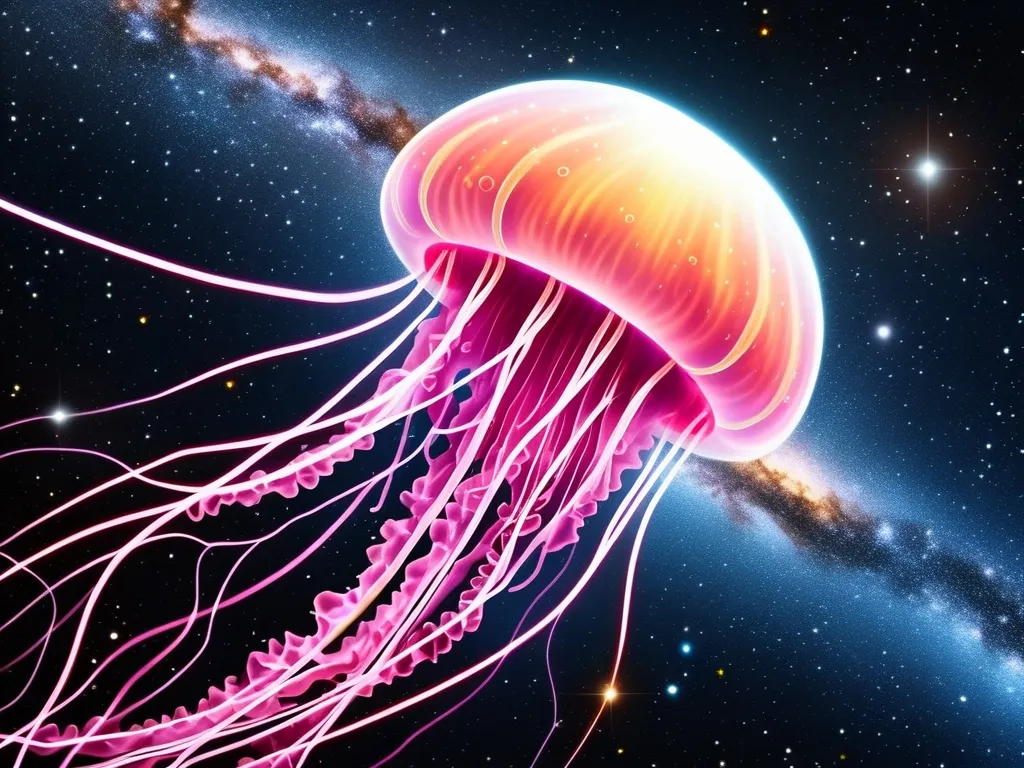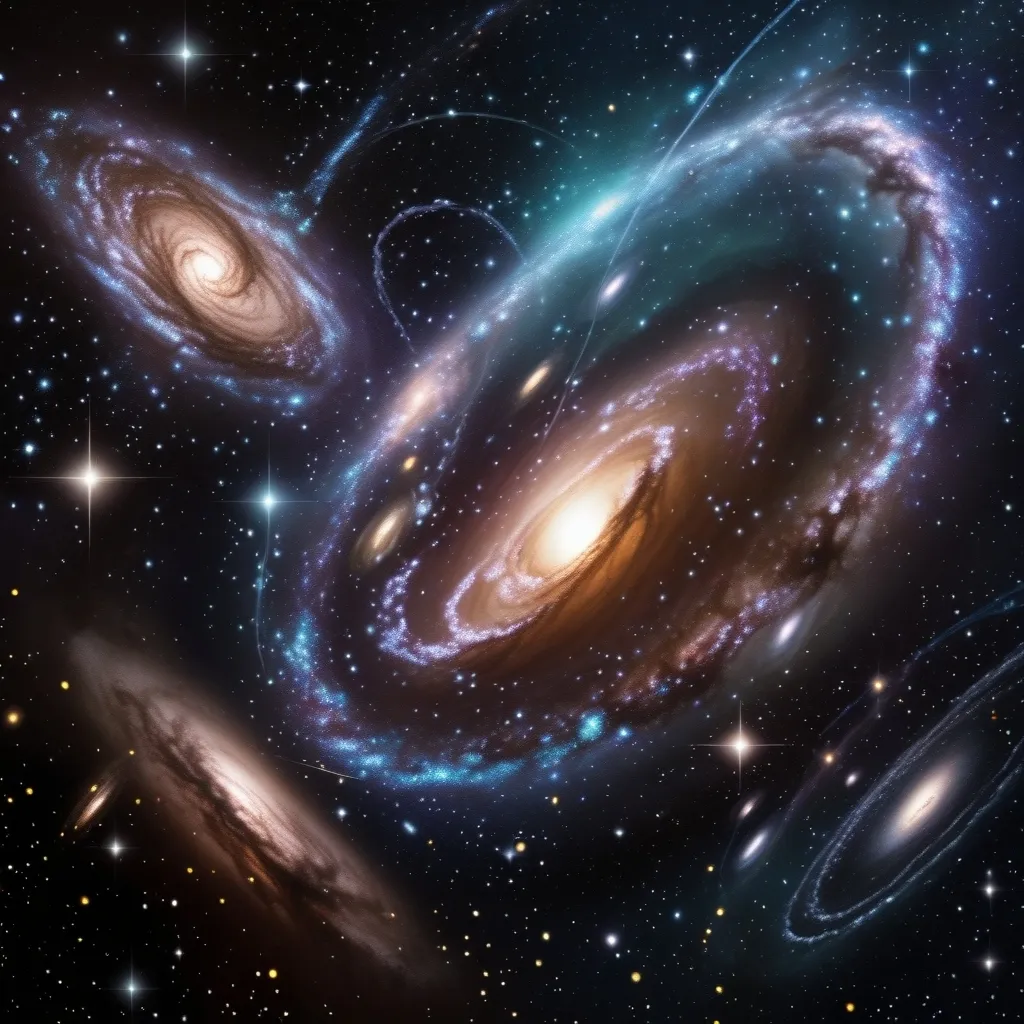As we gaze up at the starry sky, our minds often wander to the mysteries that lie beyond our planet. One of the most intriguing and enigmatic phenomena in recent astronomical observations is the “cosmic jellyfish.” These jellyfish-like structures have been spotted by astronomers and even captured by advanced telescopes, leaving us to ponder whether they are mere illusions, natural cosmic events, or something far more extraordinary.
The Discovery
One of the most notable sightings of a cosmic jellyfish was made using the Murchison Widefield Array (MWA) telescope in Western Australia. This radio telescope, a precursor to the ambitious Square Kilometer Array (SKA), observed a cluster of galaxies known as Abell 2877. The team, led by PhD candidate Torrance Hodgson, spent 12 hours observing the cluster at various radio frequencies, and what they found was nothing short of astonishing.
As they analyzed the data, a ghostly jellyfish-like structure began to emerge. This phenomenon was particularly interesting because it was bright at regular FM radio frequencies but almost disappeared at higher frequencies, around 200 MHz. This unique behavior has been challenging to explain, prompting the team to delve into the ancient history of the galaxy to understand the origins of this cosmic jellyfish.
Cosmic Archaeology
The working theory behind this jellyfish is that it is a result of powerful jets of plasma spewed out by supermassive black holes from multiple galaxies about 2 billion years ago. These jets of plasma had long since faded and lay dormant until recent events reignited them. Gentle shock waves passing through the system mixed with the plasma, briefly lighting up the jellyfish and its tentacles for us to see.
This explanation, while fascinating, still leaves room for imagination. The jellyfish, which is over a third of the Moon’s diameter when observed from Earth, can only be seen with low-frequency radio telescopes. This limitation highlights how much of the universe remains hidden from our current technological capabilities.
Optical Illusions and Celestial Misinterpretations
Not all jellyfish-like sightings in space can be attributed to complex astrophysical phenomena. Sometimes, what we see is a result of optical illusions or misinterpretations. For instance, during a SpaceX launch in 2022, a jellyfish-shaped luminous blob was observed in the trail of the Falcon 9 rocket. This was not an extraterrestrial visitor but rather a visual effect created by the launch.
Similarly, astronauts have reported seeing strange lights and shapes that, upon further investigation, turn out to be mundane objects or optical tricks. Tim Peake, a British astronaut, once reported seeing lights moving in formation while on the International Space Station, only to later realize they were likely a result of his perspective and the conditions of space.
The Role of Technology
Advanced technology plays a crucial role in distinguishing between real phenomena and illusions. The MWA telescope, for example, is capable of observing the universe at low frequencies that most other telescopes cannot. The upcoming Square Kilometer Array (SKA) promises to be even more powerful, potentially revealing many more mysterious radio jellyfish and other hidden wonders of the cosmos.
The SKA will provide an unparalleled view of the low-frequency universe, allowing scientists to create high-resolution, fast-frame-rate movies of the evolving radio universe. This could show us the formation of the first stars and galaxies, offering insights into the earliest moments of our universe.
The Human Element
The allure of the unknown is what drives many scientists and enthusiasts to explore these phenomena. The idea that we might be witnessing something truly otherworldly is a tantalizing prospect. However, it is crucial to approach these observations with a critical and scientific mindset.
For instance, the Parkes Observatory in Australia once detected strange, unexplained radio bursts that lasted for 17 years. Initially, these signals were mysterious and sparked speculation about extraterrestrial origins. However, after upgrading their equipment, the scientists discovered that the interference was caused by staff heating their lunches in a microwave oven.
Blurring the Lines
As we delve deeper into the mysteries of the cosmos, the lines between reality and fantasy often blur. The cosmic jellyfish, whether it is a natural phenomenon or an optical illusion, serves as a reminder of how much we still have to learn about the universe.
Imagine being an astronomer, poring over data from a distant galaxy, and suddenly seeing a shape that defies explanation. It is moments like these that make the pursuit of scientific knowledge so compelling. Even if the jellyfish turns out to be a natural occurrence, the journey of discovery is what makes science so fascinating.
The Future of Exploration
As technology advances and new telescopes come online, we are likely to discover many more enigmatic phenomena. The cosmic jellyfish may just be the tip of the iceberg, a hint at the vast and unexplored mysteries that lie beyond our current understanding.
Whether these phenomena are the result of complex astrophysical processes or simply our minds playing tricks on us, they inspire us to keep looking up at the stars, to keep exploring, and to never stop wondering. In the grand tapestry of the universe, the cosmic jellyfish is just one of many threads that weave together to form the intricate and awe-inspiring fabric of space.
So, the next time you gaze up at the night sky and see something that looks like a jellyfish gliding through the void, remember that it could be anything – a natural wonder, an optical illusion, or perhaps something that challenges our current understanding of the cosmos. The universe is full of mysteries, and it is up to us to unravel them, one observation at a time.






